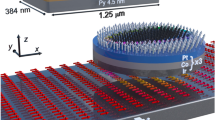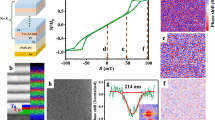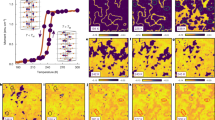Abstract
Magnetic skyrmions are topologically protected whirling spin texture. Their nanoscale dimensions, topologically protected stability and solitonic nature, together are promising for future spintronics applications. To translate these compelling features into practical spintronic devices, a key challenge lies in achieving effective control of skyrmion properties, such as size, density and thermodynamic stability. Here, we report the discovery of ferroelectrically tunable skyrmions in ultrathin BaTiO3/SrRuO3 bilayer heterostructures. The ferroelectric proximity effect at the BaTiO3/SrRuO3 heterointerface triggers a sizeable Dzyaloshinskii–Moriya interaction, thus stabilizing robust skyrmions with diameters less than a hundred nanometres. Moreover, by manipulating the ferroelectric polarization of the BaTiO3 layer, we achieve local, switchable and nonvolatile control of both skyrmion density and thermodynamic stability. This ferroelectrically tunable skyrmion system can simultaneously enhance the integratability and addressability of skyrmion-based functional devices.
This is a preview of subscription content, access via your institution
Access options
Access Nature and 54 other Nature Portfolio journals
Get Nature+, our best-value online-access subscription
$29.99 / 30 days
cancel any time
Subscribe to this journal
Receive 12 print issues and online access
$259.00 per year
only $21.58 per issue
Buy this article
- Purchase on Springer Link
- Instant access to full article PDF
Prices may be subject to local taxes which are calculated during checkout





Similar content being viewed by others
Data availability
All relevant data that support the plots within this paper are available from the corresponding author upon reasonable request.
References
Nagaosa, N. & Tokura, Y. Topological properties and dynamics of magnetic skyrmions. Nat. Nanotech. 8, 899–911 (2013).
Fert, A., Reyren, N. & Cros, V. Magnetic skyrmions: advances in physics and potential applications. Nat. Rev. Mater. 2, 17031 (2017).
Mühlbauer, S. et al. Skyrmion lattice in a chiral magnet. Science 323, 915–919 (2009).
Sampaio, J., Cros, V., Rohart, S., Thiaville, A. & Fert, A. Nucleation, stability and current-induced motion of isolated magnetic skyrmions in nanostructures. Nat. Nanotech. 8, 839–844 (2013).
Hagemeister, J., Romming, N., Von Bergmann, K., Vedmedenko, E. Y. & Wiesendanger, R. Stability of single skyrmionic bits. Nat. Commun. 6, 8455 (2015).
Yu, X. Z. et al. Real-space observation of a two-dimensional skyrmion crystal. Nature 465, 901–904 (2010).
Heinze, S. et al. Spontaneous atomic-scale magnetic skyrmion lattice in two dimensions. Nat. Phys. 7, 713–718 (2011).
Milde, P. et al. Unwinding of a skyrmion lattice by magnetic monopoles. Science 340, 1076–1081 (2013).
Jiang, W. et al. Blowing magnetic skyrmion bubbles. Science 349, 283–286 (2015).
Woo, S. et al. Observation of room-temperature magnetic skyrmions and their current-driven dynamics in ultrathin metallic ferromagnets. Nat. Mater. 15, 501–506 (2016).
Büttner, F. et al. Field-free deterministic ultrafast creation of magnetic skyrmions by spin–orbit torques. Nat. Nanotech. 12, 1040–1044 (2017).
Romming, N. et al. Writing and deleting single magnetic skyrmions. Science 341, 636–639 (2013).
Fert, A., Cros, V. & Sampaio, J. Skyrmions on the track. Nat. Nanotech. 8, 152–156 (2013).
Röβler, U. K., Bogdanov, A. N. & Pfleiderer, C. Spontaneous skyrmion ground states in magnetic metals. Nature 442, 797–801 (2006).
Dzyaloshinsky, I. A thermodynamic theory of ‘weak’ ferromagnetism of antiferromagnetics. J. Phys. Chem. Solids. 4, 241–255 (1958).
Moriya, T. Anisotropic superexchange interaction and weak ferromagnetism. Phys. Rev. 120, 91–98 (1960).
Siemens, A., Zhang, Y., Hagemeister, J., Vedmedenko, E. Y. & Wiesendanger, R. Minimal radius of magnetic skyrmions: statics and dynamics. New J. Phys. 18, 045021 (2016).
Seki, S. et al. Observation of skyrmions in a multiferroic material. Science 336, 198–201 (2012).
Kezsmarki, I. et al. Néel-type skyrmion lattice with confined orientation in the polar magnetic semiconductor GaV4S8. Nat. Mater. 14, 1116–1122 (2015).
Moreau-Luchaire, C. et al. Additive interfacial chiral interaction in multilayers for stabilization of small individual skyrmions at room temperature. Nat. Nanotech. 11, 444–448 (2016).
Soumyanarayanan, A. et al. Tunable room temperature magnetic skyrmions in Ir/Fe/Co/Pt multilayers. Nat. Mater. 16, 898–904 (2017).
Schott, M. et al. The skyrmion switch: Turning magnetic skyrmion bubbles on and off with an electric field. Nano. Lett. 17, 3006–3012 (2017).
Maccariello, D. et al. Electrical detection of single magnetic skyrmion at room temperature. Nat. Nanotech. 13, 233–237 (2018).
Ohuchi, Y. et al. Electric-field control of anomalous and topological Hall effects in oxide bilayer thin films. Nat. Commun. 9, 213 (2018).
Hsu, P. J. et al. Electric-field-driven switching of individual magnetic skyrmions. Nat. Nanotech. 12, 123–126 (2017).
Cheong, S. W. & Mostovoy, M. Multiferroics: A magnetic twist for ferroelectricity. Nat. Mater. 6, 13–20 (2007).
Ruff, E. et al. Multiferroicity and skyrmions carrying electric polarization in GaV4S8. Sci. Adv. 1, e1500916 (2015).
Chakraverty, S. et al. Multiple helimagnetic phases and topological Hall effect in epitaxial thin films of pristine and Co-doped SrFeO3. Phys. Rev. B 88, 220405(R) (2013).
Ahadi, K., Galletti, L. & Stemmer, S. Evidence of a topological Hall effect in Eu1−xSmxTiO3. Appl. Phys. Lett. 111, 172403 (2017).
Matsuno, J. et al. Interface-driven topological Hall effect in SrRuO3−SrIrO3 bilayer. Sci. Adv. 2, e1600304 (2016).
Hwang, H. Y. et al. Emergent phenomena at oxide interfaces. Nat. Mater. 11, 103–113 (2012).
Gerra, G., Tagantsev, A. K., Setter, N. & Parlinski, K. Ionic polarizability of conductive metal oxides and critical thickness for ferroelectricity in BaTiO3. Phys. Rev. Lett. 96, 107603 (2006).
Chisholm, M. F., Luo, W., Oxley, M. P., Pantelides, S. T. & Lee, H. N. Atomic-scale compensation phenomena at polar interfaces. Phys. Rev. Lett. 105, 197602 (2010).
Shin, Y. J. et al. Interface control of ferroelectricity in an SrRuO3/BaTiO3/SrRuO3 capacitor and its critical thickness. Adv. Mater. 29, 1602795 (2017).
Guo, H. et al. Interface-induced multiferroism by design in complex oxide superlattices. Proc. Natl Acad. Sci. 114, E5062–E5069 (2017).
Mattheiss, L. F. Electronic structure of RuO2, OsO2, and IrO2. Phys. Rev. B 13, 2433–2450 (1976).
Kwei, G. H., Lawson, A. C., Billinge, S. J. L. & Cheong, S. W. Structures of the ferroelectric phases of barium titanate. J. Phys. Chem. 97, 2368–2377 (1993).
Wang, L. et al. Electronic-reconstruction-enhanced-tunneling conductance at terrace edges of ultrathin oxide films. Adv. Mater. 29, 1702001 (2017).
Koster, G. et al. Structure, physical properties, and applications of SrRuO3 thin films. Rev. Mod. Phys. 84, 253–298 (2012).
Yu, X., Tokunaga, Y., Taguchi, Y. & Tokura, Y. Variation of topology in magnetic bubbles in a colossal magnetoresistive manganite. Adv. Mater. 29, 1603958 (2017).
Pollard, S. D. et al. Observation of stable Néel skyrmions in cobalt/palladium multilayers with Lorentz transmission electron microscopy. Nat. Commun. 8, 14761 (2017).
Yagil, A. et al. Stray field signatures of Néel textured skyrmions in Ir/Fe/Co/Pt multilayer films. Appl. Phys. Lett. 112, 192403 (2018).
Nakazawa, K., Bibes, M. & Kohno, H. Topological Hall effect from strong to weak coupling. J. Phys. Soc. Japan 87, 033705 (2018).
Ahn, C. H., Rabe, K. M. & Triscone, J.-M. Ferroelectricity at the nanoscale: local polarization in oxide thin films and heterostructures. Science 303, 488–491 (2004).
Cen, C. et al. Nanoscale control of an interfacial metal–insulator transition at room temperature. Nat. Mater. 7, 298–302 (2008).
Liu, X., Tsymbal, E. Y. & Rabe, K. M. Polarization-controlled modulation doping of a ferroelectric from first principles. Phys. Rev. B 97, 094107 (2018).
Ahn, C. H. et al. Electrostatic modification of novel materials. Rev. Mod. Phys. 78, 1185–1212 (2006).
Dawber, M., Rabe, K. M. & Scott, J. F. Physics of thin-film ferroelectric oxides. Rev. Mod. Phys. 77, 1083–1130 (2005).
Kresse, G. & Furthmüller, J. Efficient iterative schemes for ab initio total-energy calculations using a plane-wave basis set. Phys. Rev. B 54, 11169–11186 (1996).
Xiang, H. J., Kan, E. J., Wei, S. H., Whangbo, M.-H. & Gong, X. G. Predicting the spin-lattice order of frustrated systems from first principles. Phys. Rev. B 84, 224429 (2011).
Yang, H., Thiaville, A., Rohart, S., Fert, A. & Chshiev, M. Anatomy of Dzyaloshinskii–Moriya interaction at Co/Pt interfaces. Phys. Rev. Lett. 115, 267210 (2015).
Perdew, J. P., Burke, K. & Ernzerhof, M. Generalized gradient approximation made simple. Phys. Rev. Lett. 77, 3865–3868 (1996).
Zhou, H. et al. Evolution and control of the phase competition morphology in a manganite film. Nat. Commun. 6, 8980 (2015).
Acknowledgements
Q.L., W.M. and Q.F. were supported by the National Key R&D Program of China (grants no. 2017YFA0402903 and no. 2016YFA0401003) and the National Natural Science Foundation of China (grant no. 51627901). J.H.H. was supported by Samsung Science and Technology Foundation under Project Number SSTF-BA1701-07. STEM and PPMS measurements were supported by the National Center for Inter-University Research Facilities (NCIRF) at Seoul National University in Korea. All the authors want to acknowledge major support from the Research Center Program of IBS (Institute for Basic Science) in Korea (IBS-R009-D1). We also acknowledge invaluable suggestions and support from S.Y. Park, S.M. Yang, S. H. Chang, C. Kim, J.-G. Park, B.J. Yang, T.H. Kim, W. Wu and Y. Wang.
Author information
Authors and Affiliations
Contributions
L.W. and T.W.N. conceived the idea and designed the experiments. R.K. performed the first-principles DFT calculations. L.W. and Y.J.S. grew the samples, fabricated the Hall bar devices and performed the PFM measurements. Y.K. and M.Y.K. performed the STEM measurements. Q.F., H.Z., W.M. and Q.L. performed the MFM measurements. S.D.P., K.H.L. and H.Y. performed the numerical simulations on skyrmion stability. L.W. and T.W.N. analysed the results and wrote the manuscript. All authors participated in the discussions during manuscript preparation.
Corresponding authors
Ethics declarations
Competing interests
The authors declare no competing interests.
Additional information
Publisher’s note: Springer Nature remains neutral with regard to jurisdictional claims in published maps and institutional affiliations.
Supplementary information
Supplementary Information
Supplementary Sections 1–10, Supplementary Figures 1–26, Supplementary Notes 1–2, Supplementary References 1–29
Rights and permissions
About this article
Cite this article
Wang, L., Feng, Q., Kim, Y. et al. Ferroelectrically tunable magnetic skyrmions in ultrathin oxide heterostructures. Nature Mater 17, 1087–1094 (2018). https://doi.org/10.1038/s41563-018-0204-4
Received:
Accepted:
Published:
Issue Date:
DOI: https://doi.org/10.1038/s41563-018-0204-4
This article is cited by
-
Flexoelectric polarizing and control of a ferromagnetic metal
Nature Physics (2024)
-
The anti-symmetric and anisotropic symmetric exchange interactions between electric dipoles in hafnia
Nature Communications (2023)
-
Record high room temperature resistance switching in ferroelectric-gated Mott transistors unlocked by interfacial charge engineering
Nature Communications (2023)
-
Magnetism and berry phase manipulation in an emergent structure of perovskite ruthenate by (111) strain engineering
npj Quantum Materials (2023)
-
Electric-field control of topological spin textures in BiFeO3/La0.67Sr0.33MnO3 heterostructure at room temperature
Rare Metals (2023)



